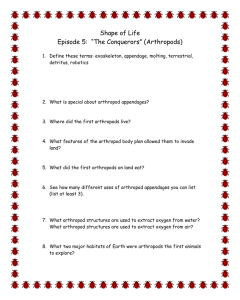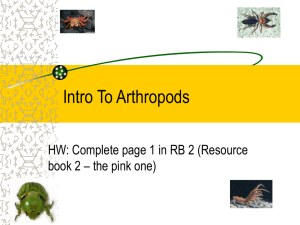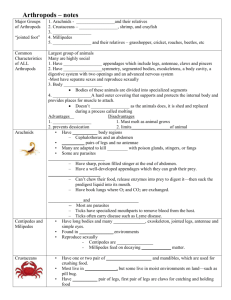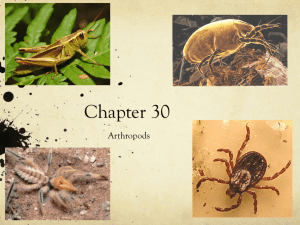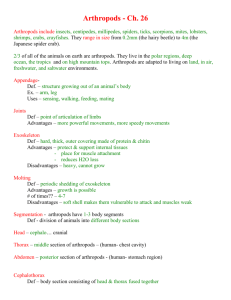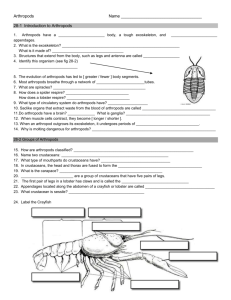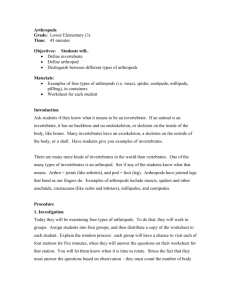Arthropods share some characteristics with many other animals, too
advertisement
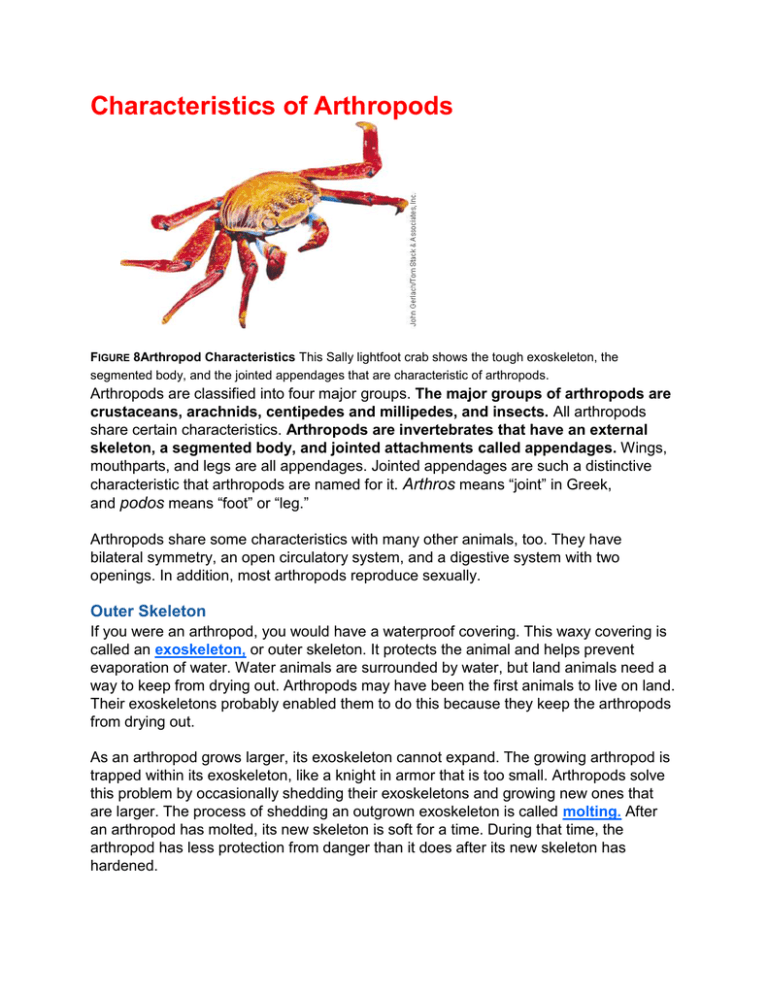
Characteristics of Arthropods FIGURE 8Arthropod Characteristics This Sally lightfoot crab shows the tough exoskeleton, the segmented body, and the jointed appendages that are characteristic of arthropods. Arthropods are classified into four major groups. The major groups of arthropods are crustaceans, arachnids, centipedes and millipedes, and insects. All arthropods share certain characteristics. Arthropods are invertebrates that have an external skeleton, a segmented body, and jointed attachments called appendages. Wings, mouthparts, and legs are all appendages. Jointed appendages are such a distinctive characteristic that arthropods are named for it. Arthros means “joint” in Greek, and podos means “foot” or “leg.” Arthropods share some characteristics with many other animals, too. They have bilateral symmetry, an open circulatory system, and a digestive system with two openings. In addition, most arthropods reproduce sexually. Outer Skeleton If you were an arthropod, you would have a waterproof covering. This waxy covering is called an exoskeleton, or outer skeleton. It protects the animal and helps prevent evaporation of water. Water animals are surrounded by water, but land animals need a way to keep from drying out. Arthropods may have been the first animals to live on land. Their exoskeletons probably enabled them to do this because they keep the arthropods from drying out. As an arthropod grows larger, its exoskeleton cannot expand. The growing arthropod is trapped within its exoskeleton, like a knight in armor that is too small. Arthropods solve this problem by occasionally shedding their exoskeletons and growing new ones that are larger. The process of shedding an outgrown exoskeleton is called molting. After an arthropod has molted, its new skeleton is soft for a time. During that time, the arthropod has less protection from danger than it does after its new skeleton has hardened. FIGURE 9A Molting Cicada This cicada has just molted. You can see its old exoskeleton hanging on the leaf just below it. Applying Concepts Why must arthropods molt? Segmented Body The bodies of arthropods are segmented. A segmented body plan is easiest to see in centipedes and millipedes, which have bodies made up of many identical-looking segments. In fact, their bodies look something like the bodies of earthworms. You can also see segments on the tails of shrimp and lobsters. In some groups of arthropods, several body segments become joined into distinct sections. An arthropod may have up to three sections—a head, a midsection, and a hind section. Jointed Appendages Just as your fingers are appendages attached to your palms, many arthropods have jointed appendages attached to their bodies. The joints in the appendages give the animal flexibility and enable it to move. If you did the Discover activity, you saw how important joints are for allowing movement. Arthropod appendages tend to be highly specialized tools used for moving, obtaining food, reproducing, and sensing the environment. For example, arthropods use legs to walk and wings to fly. In addition, most arthropods have appendages called antennae (singularantenna). An antenna is an appendage attached to the head that contains sense organs. Diversity Scientists have identified more species of arthropods—over one million—than all other species of animals combined! There are probably many others that have not yet been discovered. Look at Figure 10 to compare some characteristics of the four major groups of arthropods. Crustaceans If you’ve ever eaten shrimp cocktail or crab cakes, you’ve dined on crustaceans(krus TAY shunz). Crayfish and lobsters are other familiar crustaceans. Crustaceans thrive in freshwater lakes and rivers, and even in puddles that last a long time. You can find them in the deepest parts of oceans and along coastlines. A few, like the pill bug, live in damp places on land. Body Structure Crustaceans share certain characteristics. A crustacean is an arthropod that has two or three body sections, five or more pairs of legs, and two pairs of antennae. Each crustacean body segment has a pair of legs or another type of appendage attached to it. The various types of appendages function differently, as you can see in Figure 11. FIGURE 11Crayfish AppendagesA crayfish’s appendages are as varied as the tools on a Swiss army knife. The appendages are adapted for different functions.Interpreting Diagrams What functions do the chelipeds serve? The appendages attached to the head of a crayfish include two pairs of antennae that are used for smelling, tasting, touching, and keeping balance. The crayfish uses most of its leg appendages for walking. However, it uses its first pair of legs, called chelipeds, for obtaining food and defending itself. Obtaining Oxygen and Food Because crustaceans live in watery environments, most have gills to obtain oxygen. The gills are located beneath the shell of a crustacean. Water containing oxygen reaches the gills as a crustacean moves along in its environment. Crustaceans obtain food in many ways. Some are scavengers that eat dead plants and animals. Others are predators, eating animals they have killed. The pistol shrimp is a predator with an appendage that moves with such force that it stuns its prey. Krill, which are shrimplike crustaceans that live in cold ocean waters, are herbivores that eat plantlike microorganisms. In turn, krill are eaten by predators such as fishes, penguins, seals, and even great blue whales, the world’s largest animals. Life Cycle Most crustaceans, such as crabs, barnacles, and shrimp, begin their lives as microscopic, swimming larvae. The bodies of these larvae do not resemble those of adults. Crustacean larvae develop into adults by metamorphosis (met uh MAWRfuh sis), a process in which an animal’s body undergoes dramatic changes in form during its life cycle. Arachnids Spiders, mites, ticks, and scorpions are the arachnids (uh RAK nidz) that people most often meet. Arachnids are arthropods with two body sections, four pairs of legs, and no antennae. Their first body section is a combined head and midsection. The hind section, called the abdomen, is the other section. The abdomen contains the reproductive organs and part of the digestive system. Spiders Spiders are probably the most familiar, most feared, and most fascinating kind of arachnid. All spiders are predators, and most of them eat insects. Some, such as tarantulas and wolf spiders, run down their prey. Others, such as golden garden spiders, spin sticky webs to trap their prey. FIGURE 13Red Knee Tarantula This red knee tarantula lives in an underground burrow. The spider uses fangs to inject venom into its prey. Spiders have hollow fangs through which they inject venom into their prey. Spider venom turns the tissues of the prey into mush. Later the spider uses its fangs like drinking straws, and sucks in the food. In spite of what some people might think, spiders rarely bite people. When spiders do bite, their bites are often painful but not lifethreatening. However, the bite of a brown recluse or a black widow may require hospital care. Mites If chiggers have ever given you an itchy rash, you’ve had an unpleasant encounter with tiny arachnids called mites. Chiggers and many other mites are parasites. Ear mites, for example, give dogs and cats itchy ears. Mites are everywhere. Even the cleanest houses have microscopic dust mites. If you are allergic to dust, you may actually be allergic to the exoskeletons of dust mites. In addition to living in dry areas, mites also live in fresh water and in the ocean. FIGURE 14Dust Mite This microscopic dust mite feeds on dead skin and hair shed by humans. Classifying Would you describ Scorpions Scorpions live mainly in hot climates, and are usually active at night. During the day, scorpions hide in cool places—under rocks and logs, or in holes in the ground, for example. At the end of its abdomen, a scorpion has a spinelike stinger. The scorpion uses the stinger to inject venom into its prey, which is usually a spider or an insect. FIGURE 15Scorpion A scorpion is a carnivore that injects venom from a stinger at the end of its abdomen. Ticks Ticks are parasites that live on the outside of a host animal’s body. Nearly every kind of land animal has a species of tick that sucks its blood. Some ticks that attack humans can carry diseases. Lyme disease, for example, is spread by the bite of an infected deer tick. You can see an enlarged deer tick below. In reality, a deer tick is just a few millimeters long. Deer tick Centipedes and Millipedes FIGURE 16Centipede and Millipede Both centipedes and millipedes have many pairs of legs. Interpreting Photographs How many pairs of legs does each segment of the centipede have? Centipedes and millipedes are arthropods with two body sections and many pairs of legs. The two body sections are a head with one pair of antennae, and a long abdomen with many segments. Centipedes have one pair of legs attached to each segment. Some centipedes have more than 100 segments. In fact, the word centipede means “hundred feet.” Centipedes are swift predators that inject venom into their prey. Millipedes, which may have more than 80 segments, have two pairs of legs on each segment—more legs than any other arthropod. Though millipede means “thousand feet,” they don’t have quite that many legs. Most millipedes are scavengers that graze on partly decayed leaves. When they are disturbed, millipedes can curl up into a ball, protected by their tough exoskeleton. Some will also squirt an awful-smelling liquid at a potential predator. Section 3 Insects Body Structure Insect Adaptations Moths are insects, as are caterpillers, plant hoppers, dragonflies, cockroaches, and bees. You can identify insects, like other arthropods, by counting their body sections and legs. Insects are arthropods with three body sections, six legs, one pair of antennae, and usually one or two pairs of wings. The three body sections are the head, thorax, and abdomen, as you can see in Figure 17. FIGURE 17Structure of a Grasshopper A grasshopper’s body, like that of every insect, has three sections. Head Most of an insect’s sense organs, such as the eyes and antennae, are located on the head. Insects usually have two large compound eyes. These eyes contain many lenses, which are structures that focus light to form images. Compound eyes are especially keen at seeing movement. Most insects also have small simple eyes that can distinguish between light and darkness. Thorax An insect’s midsection, or thorax, is the section to which wings and legs are attached. Most species of insects can fly once they are adults. Insects are the only invertebrates that can fly. By flying, insects can travel long distances to find mates, food, and new places to live. Being able to fly also enables insects to escape from many predators. Abdomen Inside the abdomen are many of the insect’s internal organs. Small holes on the outside of the abdomen lead to a system of tubes inside the insect. These tubes allow air, which contains oxygen, to enter the body. The oxygen in the air travels directly to the insect’s cells.

